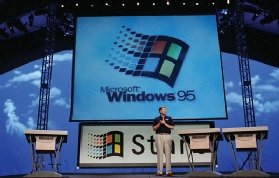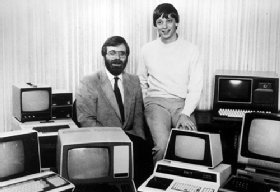Formed in 1975, Microsoft is currently celebrating its 50th anniversary, having powered the personal computing revolution first with MS-DOS, and then with Windows.
In the 1980s, it demonstrated – thanks to the IBM Project Chess, one of the first personal computers – that business computing could be accessed by anyone and wasn’t simply a task to be left to the bods who worked in server rooms.
And thanks to VisiCalc – a spreadsheet program that had originally been written for the Apple II – when the IBM PC arrived in 1981, it had a killer application, enabling business users to crunch away at numbers without having to send requests to the data processing department.
Breakthroughs of the nineties
But the 1990s marked a shift in personal computing from the command-line interface of the MS-DOS operating system to a graphical user interface (GUI) with Windows.
There was also the break-up of the marriage between IBM and Microsoft, which had served both companies so well. IBM went on to push an operating system called OS/2 to its die-hard customers, and began talking to Apple and Motorola to develop a rival to the PC’s x86 architecture, called PowerPC.
Meanwhile, Microsoft had been working to get its buggy Windows GUI fixed. Things only really started improving in 1990 with the availability of Windows 3. By 1993, it was beginning to develop a server operating system, Windows NT, to run the SQL Server relational database, which, incidentally, began life as a joint venture with Sybase and Ashton-Tate, and originally ran on the IBM OS/2 operating system.
At that time, some amazing developments were taking place. The World Wide Web was starting to take shape and was available to anyone thanks to the Mosaic browser. And in 1995, Windows 95 was launched – Microsoft’s first fully GUI-based operating system.

Meanwhile, Linux was gaining traction as an alternative to proprietary Unix servers in the datacentre. Microsoft wanted to grab a piece of this market, so, in 1996, it introduced Exchange, an email server that ran on top of the Windows NT Server operating system.
By the turn of the century, Microsoft’s server offerings were beginning to take shape, thanks in part to the stability of the rebranded server operating system – first Windows 2000, then Windows Server 2003.
The upgrade dilemma
Meanwhile, on the desktop, Microsoft was trying to get people to move to Windows XP, but many users stuck with the older Windows Me operating system. This is something that has continued to affect Windows users with each new version.
In October this year, Microsoft will introduce its latest version of Windows. Windows 10 will be officially retired in the same month, and users of Windows 11, which was launched in October 2021, will have five years to migrate to the new operating system.
While many organisations are well-versed in this five-year cycle, with IT teams geared up to updating the desktop estate, the upgrade to a new version of Windows tends to raise the minimum level of hardware that the operating system will run on. This means older hardware may not be compatible with the new operating system, which then drives up purchases of new PCs.
Over the past year, Microsoft has also been getting its customers ready for the age of artificial intelligence (AI) on the desktop, where every PC will need a neural processing unit (NPU) to run local AI inference tasks.
Love for developers
Former Microsoft CEO Steve Ballmer famously chanted “developers” as he clapped and walked across the stage at a Microsoft software developer event.
One of the things Paul Allen and Bill Gates realised when they formed Microsoft in 1975 was the power of supporting a software developer community. It began with Microsoft Basic – which stands for beginner’s all-symbolic instruction code – to provide a programming language for the world’s first microcomputer, the Altair 8080. The Basic interpreter was widely licensed, which meant popular home computers of the 1980s included variants of Microsoft Basic.
With Windows, it introduced a software developer kit (SDK) in a bid to create an ecosystem for developers to write software that could run on the new Microsoft platform. This not only opened the floodgates to the development of Windows applications, but also led to Windows-based integrated development environments (IDEs), which allow software developers to write and test code within a single user interface. Microsoft’s own IDE, Visual Studio, has become a de facto standard for Windows developers.

Relationship with regulators
Throughout its history, Microsoft has focused on creating standards to help drive the adoption of its technology. The PC used to be described as an industry standard architecture (ISA), which enables Windows to run, and the annals of computing are littered with now-defunct Microsoft-led industry standards and attempts at open standards.
It has committed to publishing technical documents for protocols implemented in Windows Client, Windows Server, Office, SharePoint, Exchange Server and SQL Server, which are used to communicate with other Microsoft software products. The goal for Microsoft is that by using these protocols, third-party developers are creating products that use Microsoft products.
Its business practices regarding these protocols, and the fact that it has bundled functionality into Windows, mean Microsoft has often found itself on the wrong side of competition laws. In 2000, it was found guilty of anti-competitive practices after bundling its Internet Explorer browser in Windows. And more recently, EU regulators fined Microsoft €2.2bn for bundling Teams with its Office 365 and Microsoft 365 products.
Change of tack with open source
There was a time when Microsoft was going head-to-head with the likes of Red Hat and SuSE to position Windows Server as an alternative to Linux and open source technology in the datacentre. But, in many ways, the company has had to embrace open source to keep developers happy.
In a breathtaking move, it acquired the open source repository GitHub in 2016 for $7.6bn.
Windows also includes a Linux subsystem, which enables Linux administrators to use the command line tools they are accustomed to within the Windows environment.
The cloud and AI
Despite Amazon Web Services (AWS) being the first public cloud, Microsoft has steadily grown its Azure public cloud to become a major rival. Part of its success is that the company has a long history of working with Windows enterprise customers.
Just as many of its products have become embedded in corporate IT, Microsoft’s relationship with these customers has put it in a prime position to cross-sell and upsell Azure and cloud-based services. Looking at the fourth quarter 2024 market share data among the leading cloud providers, Amazon is top at 30%, followed by Microsoft with 21% and Google Cloud at 12%.

Microsoft’s 2023 $10bn investment in OpenAI, the creator of ChatGPT, enabled the company to propel itself forward in the era of AI and is likely to bolster its public cloud growth.
“Our assessment is that since ChatGPT was launched, GenAI [generative AI] has been responsible for at least half of the increase in cloud service revenues. That has come from either newly launched GenAI/GPU [graphics processor unit] services or from AI-driven improvements to existing cloud services,” said John Dinsdale, chief research analyst at Synergy Research Group.
What next?
Satya Nadella has been CEO of Microsoft since 2014. Under his leadership, the company has become a leading AI business, but one of the questions Microsoft is likely to face going forward is how it will evolve LinkedIn, which it acquired in 2016 for over $26bn.
According to a transcript of its second quarter 2025 results, the professional social media network has an annual revenue of $2.2bn and is expected to experience “low to mid single-digit” growth this year.
However, Microsoft has yet to make its position clear on how LinkedIn fits alongside the rest of its enterprise software portfolio.





